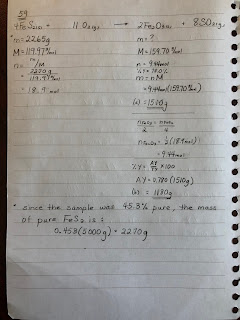All
the calculations done to date show the
theoretical yield (TY) of a product, that is, the maximum amount of product that
can be formed if all reactants are converted to products.
In
real life, this is not always the case – we do not always get 100% of the
products. There are many reasons why the
percentage yield (%Y) is not always 100%:
- side reactions may occur, producing undesired products and reducing the amount of the desired products - you have very little control over this
- the reaction may not go to completion - you have very little control over this
- the
experimental technique may result in a loss of products - you have a lot of control over this, so be careful and this shouldn't be a big problem
Regardless
of the reason, the actual yield (AY) is rarely equivalent to the theoretical
yield.
We can calculate the theoretical yield, using paper and pencil as usual. We can determine the actual (or experimental) yield by carrying out the experiment in the laboratory.
% Yield = Actual Yield x
100
Theoretical Yield
ex. In a reaction, 1250 g of methane is
reacted with excess water to produce carbon dioxide and hydrogen gas. If 3000 g of carbon dioxide is actually collected
by the experimenter during the reaction, what is the percentage yield?
CH4(g) + 2H2O(g) → CO2(g) + 4H2(g)
m = 1 250 g AY = 3 000 g
M = 16.043 g/mol %Y = ?
m = TY
= ?
M = 44.011 g/mol
n = 77.9 mol
n
= m/M
= 1 250 g/16.043 g/mol m = nM
= 77.9 mol =(77.9 mol)(44.011 g/mol)
= 3430 g
nCH4/1
= nCO2/1
nCO2 = 77.9 mol %Y = (AY/TY) x
100
= (3000 g/3430 g) x
100
= 87.46%
= 90%
Procedure:
- Create a balanced reaction equation.
- List known and unknown data in columns beneath appropriate substances.
- First we must determine the theoretical yield of the product. Do this as you have done in the past (find moles of R, set up mole ratio between R & P, find mass of P). The mass of the product is the theoretical yield of the product.
- Find the % yield of the product using the theoretical yield just calculated and the actual yield given in the question.
Reminder: Keep all digits from your calculations as you proceed through the question. Only round for real at the final answer.
Homework: Practice p. 316 #13, 14; Practice p. 319 #52, 53, 59, 60
2. Might as well do #13 & 14, too.






